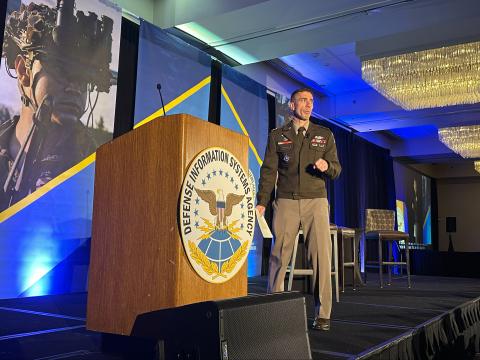Information Technology Company Closing Deals
A new president is part of a major acquisition, scores new contracts.
As a young pilot in the U.S. Navy, S. Daniel Johnson liked the thrill of taking off from and landing on aircraft carriers in the Mediterranean and the
So when he shipped back to the
Attending the university part time, he completed his MBA in 1975 and then left the Navy. He entered the business world as a consultant with what is now known as KMPG, a global provider of audit, tax and advisory services. Today, 33 years, several corporate acquisitions and a public stock offering later, the 60-year-old Johnson stands at the top of the field for federal information technology (IT) services, much of which is focused on defense and intelligence agencies.
On April 1 he became president of General Dynamics Information Technology, or GDIT. It is a roughly $3 billion business unit of General Dynamics that employs about 15,000 people. The unit resulted from the 2006 acquisition of Anteon Corp., a fast-growing technology concern in which Johnson served as chief operating officer.
Johnson acknowledges that he has been on a “pretty fast track. “Actually, I love it,” he emphasizes. “It’s been a great career.”
While acquisitions are part of the federal IT arena, Johnson is not relying exclusively on them for company growth. Drawing on his diverse background, he is looking to lead GDIT into new markets that draw directly on its expertise.
Considered a consummate operations man with a firm grasp of business details, Johnson says he surrounds himself with executives who have deep technological expertise. He works hard at maintaining good relationships with his customers.
After all, he faces some pretty tough competition in the federal IT services market: at the upper end are Lockheed Martin, Northrop Grumman, CSC, EDS and SAIC, along with several middle-market concerns that excel at capturing and servicing government contracts that can start small and eventually entail hundreds of millions of dollars in revenues.
Clearly, Johnson believes that GDIT’s recent string of contract wins shows the unit has a unique value proposition. But, he says, don’t underestimate the power of the personal touch.
“There is one other aspect that I’ll mention that I think is a differentiator, and I hear it when I go out and visit with customers—and I try to go visit with them before they demand that I come talk to them because there’s a problem,” Johnson declares. “We’re pretty focused on organizing ourselves by customer and going to market by customer.
“The commitment to the mission of the customer is paramount for most of our people. And when I go to visit with customers, they’ll tell me, ‘you know, your folks are as committed to what it is I’m trying to do as my own people are. And what sort of sets you apart is [that] your management is [committed] as well.’
“In other words, they don’t nit-pick me on changes,” he continues. “They try to keep the big picture and work with me within the limitations that I have, and there’s sort of a one-team, one-fight kind of concept. I’m not sure, but I don’t hear that a lot from some of our competitors.”
Johnson says he is branding the unit as a “pure play” services provider because the concern doesn’t sell products. That differs sharply from the rest of General Dynamics, which is well known as a builder of major platforms such as ships, jets, tanks and tracked vehicles.
The creation of GDIT may reflect the transformation of the federal IT services market marked by several dozen acquisitions in recent years. The major players are vying for more contract dollars in what is expected to be an era of shrinking federal budgets.
On May 14, venerable computer maker Hewlett-Packard pulled off a bold move that vaulted it into the number two position in the technology services market after IBM. By agreeing to pay $13.9 billion for EDS of Plano, Texas, HP also set itself up to become a major player in the federal IT market, where EDS has a long history of winning and managing contracts with a wide array of civilian and defense agencies. Industry observers note EDS had $2.5 billion in large federal contracts last fiscal year, a figure five times greater than that of HP.
Meanwhile, declining defense budgets don’t worry Johnson, who says he expects high single digit growth from internal sources and possibly some strategic acquisitions. He says nearly all federal agencies need to do more with less, meaning they will remain technology clients for the foreseeable future.
Beyond that, civilian agencies and the Defense Department still have large legacy systems that need to be upgraded. For example, he would like to move GDIT into the medical records market because the nation has so many retired and active duty military personnel whose records will need to be updated to improve efficiency as well as patient health.
Johnson assumes command at a time when GDIT is on a roll. Since its creation in 2006, the unit has announced 27 federal contracts worth about $3 billion. He indicates the actual number could be substantially higher after factoring in the value of classified intelligence contracts.
If you were to ask me what two pieces of our pie we are really focusing on, it would be intelligence and homeland security within the civil agencies,” Johnson says. “And we keep track of the large opportunities that are coming out—there’s a huge information technology improvement program opportunity coming out of the Transportation Security Administration here within the next six to eight months.
“So we are garnering up to go after that one, and we think we have a good shot there. We have a couple of huge wins on the intelligence side. I can’t give you the names of them because they are classified, but they are huge. One I’m thinking of in particular is over a half a billion dollars; and again, it’s network infrastructure, information technology consolidation of a number of different organizations within the intelligence community.”
Just three weeks after Johnson became president, GDIT announced a $79 million award for a follow-on contract to provide information support to the U.S. Army Reserve Command. That followed a March announcement of a $191 million contract for the Naval Sea Systems Command to provide support to the Missile Defense Agency’s Aegis ballistic missile defense.
In July 2007, the unit announced it was one of 29 companies awarded a General Services Administration Alliant contract to provide federal agencies with integrated information technology solutions for evolving needs on a global basis. This sprawling 10-year contract could total $50 billion for all the players involved, but Johnson noted that at press time the program was on hold because of a protest by a company not included in the list of winners.
In December 2006, GDIT got part of a $1.9 billion five-year award from the Air Force Ogden Air Logistics Center. General Dynamics will provide design and engineering technical support services for Defense Department mission weapon systems, components and support equipment.
Winning big contracts is one of the reasons Johnson strongly favored the Anteon merger under which General Dynamics folded in its Network Systems (GDNS) division to form the new IT unit. For its part, Anteon had made quite a bit of noise in the federal market in a short period of time.
Technically, Anteon could trace its roots to the 1970s, but in reality the enterprise was started with an acquisition in 1996. About two years later, it made a third acquisition that vaulted it to $250 million in sales. The company went public in 2002, and by the time General Dynamics paid $2.1 billion in cash to buy the company, Anteon had made six acquisitions and had an annual run rate of $1 billion in revenue.
But, says Johnson, Anteon faced a contracting Catch-22. It excelled at getting small awards that would lead to increasing revenues, but it couldn’t crack the big awards—those of several hundred million dollars or more—because it had no history of capturing such large projects outright.
General Dynamics, on the other hand, is a defense industry titan with decades of experience on huge projects. So, Johnson says, he saw a natural synergy in the combined concern—one with a history of closing deals and growing quickly and a company that is on the top of nearly every Defense Department official’s list of valued vendors.
“The way we were going to market at Anteon and the way GDNS was going to market were very compatible,” he says of the merger. “We had pretty much aligned ourselves in both cases by customer. In other words, we had all of our Navy work together, we had all of our Air Force work together, and we had all of our Army work together.
“When it came to putting the organization together, you didn’t have to fool around with those family units,” he explains. “They just sort of absorbed each other. General Dynamics made a conscious big investment to get into the services market and, of course, Anteon and the senior executive leadership there spent a lot of time and effort trying to build a world-class services organization with the infrastructure to support that kind of market.
“To General Dynamics’ credit, they implemented a significant portion of the infrastructure which helped support one of those high-transaction/high-growth delivery order kinds of businesses. And we have successfully implemented that architecture, if you will, into our combined organizations. All things considered, I think it’s been a rousing success,” he declares.
Web Resource
General Dynamics Information Technology: www.anteon.com




Comments